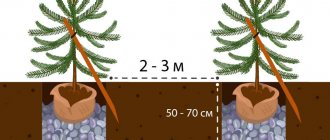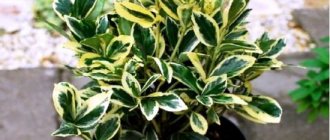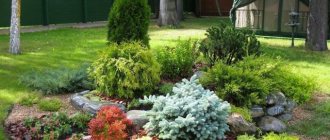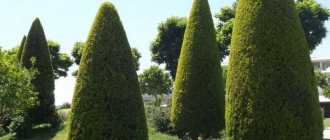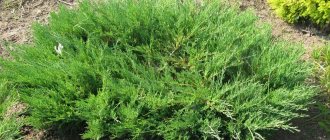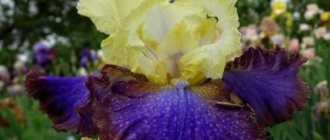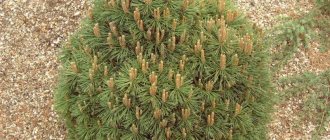Author: Natalya Category: Garden plants Published: February 23, 2019Last edits: November 4, 2020
- Seed propagation
Western thuja (lat. Thuja occidentalis), or life tree , is an evergreen coniferous plant of the Thuja genus of the Cypress family. In nature, this species is found in eastern North America along low-lying river banks, swamps, on calcareous soils and moist fertile loams. The plant was described by Carl Linnaeus in 1753, at which time it received its name from him, which is translated from Greek as “sacrifice, incense”: aromatic thuja species were burned during ancient religious rites. Currently, thuja occidentalis, due to its winter hardiness, durability, resistance to toxic urban conditions and a large number of artificially bred decorative forms, has become widespread in all climatic zones.
Planting and caring for thuja occidentalis
- Planting: in spring, before sap flow begins.
- Lighting: bright sunlight or partial shade.
- Soil: moderately moist, permeable soils.
- Watering: for the first month after planting, seedlings need to be watered every week, spending up to 10 liters of water per plant, and in drought - up to 15-20 liters. In addition, once a week, in the evening, the crowns of seedlings should be sprayed or irrigated from a watering can with a shower head with non-cold water at a flow rate of 15-20 liters per seedling, and in dry and hot weather, sprinkling is carried out twice a week.
- Fertilizing: in spring with complex mineral fertilizer.
- Pruning: Thuja does not need formative pruning, since during the process of growth its crown itself takes on a geometric shape corresponding to the variety. Sanitary cleaning is carried out in early spring, summer and autumn, choosing a cloudy day for this.
- Reproduction: seeds and woody cuttings.
- Pests: thuja aphids, thuja false scale insects and moths.
- Diseases: tracheomycosis, fusarium, browning of shoots.
Read more about growing thuja occidentalis below.
Thuja occidentalis Recurva Nana
T. occidentalis 'Recurva Nana' is a low-growing shrub. It reaches a maximum height of two meters at about 40 years of age. The crown diameter at this age is also 2 m. It grows quite slowly. The average increase in both height and crown diameter is 4 cm per year. The plant's habit varies from ovoid-spherical to classic spherical. The crown is dense, formed by thin, almost vertically growing needle-bearing shoots.
There are two types of needles - scaly and needle-shaped. Needle-like is characteristic of younger shoots. The color of the needles is green, regardless of the time of year. Photophilous. But it also develops well in partial shade. It tolerates shade, but loses habit, crown density, and may even begin to dry up.
Drought resistant. However, it does not like direct exposure to strong winds. In leeward areas it requires cover, especially in the first few years after planting.
One of the few forms of western thuja that reacts heavily to industrial gas and dust emissions. It especially does not like the presence of sulfur oxides in the atmospheric air.
It tolerates air dryness easily, but when using sprinkling it looks somewhat more decorative.
Loves light, well-moistened soils. Doesn't like heavy waterlogging. In this case, drainage is required. It is practically indifferent to soil fertility, although, quite naturally, it develops better on fresh, well-humused loamy and sandy loams. Tolerates soil acidity from pH 4.5 to pH 6.5. Frost-resistant down to -30°C.
Botanical description
The height of the western thuja, this slow-growing tree, can reach 20 m, although there are specimens up to 40 m in height. The root system of the plant is compact, the crown is ovoid or pyramidal. In young trees, the bark is red-brown, smooth, over time it acquires a gray-brown color and begins to separate from the trunk in longitudinal narrow stripes. The upper side of the shoots is shiny, dark green, the lower side is matte and lighter. The needles are green, brownish or brown in winter, scaly, small, tightly pressed to the shoot. The needles live for 2-3 years, after which they fall off along with small branches. The fruits of the thuja occidentalis are small ovoid cones, consisting of thin scales and containing a pair of flattened seeds with narrow straw-yellow wings. Thuja wood is aromatic, reddish, relatively soft, but durable and without resin ducts. Its advantage is that it does not rot.
Growing thuja - planting and garden care
Western thuja is shade-tolerant and winter-hardy, its shoots become completely lignified. The plant is durable, resistant to gas and smoke and has over 120 decorative forms.
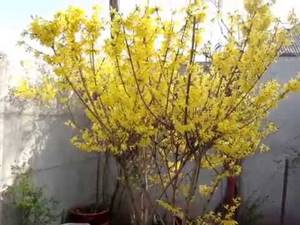
The most interesting varieties
Many other varieties of this crop are known. The following varieties are extremely popular: Brabant, Smaragd, Danika, Globoza. Specialty stores and nurseries also have more unique and less common varieties. Below are the names of the western thuja varieties and their brief descriptions.
Little Boy is a relatively new dwarf spherical variety. The height does not exceed 0.5 meters. Growth is slow. The needles of this thuja have an emerald color. Little Boy requires high soil fertility. Loves the sun, but is not averse to growing in partial shade. This thuja is used to create:
- Japanese gardens;
- Living borders.
Hoseri is an original variety originally from Poland. This is another dwarf globular tree species. The scale-like needles are dark green in color. In autumn, the needles take on a bronze hue. Hoseri loves moisture, is not picky about the soil and is shade-tolerant. This crop is also frost-resistant and not afraid of winds.
Mirjem is another dwarf thuja variety. An adult plant grows up to 80 cm. The needles have a bright yellow color, becoming bronze by autumn. Plant growth is slow. Due to its size, this thuja is an ideal option for rock gardens and planting in pots.
Brabant is a thuja that has a large height. The height of the trees is up to 21 meters. Used in group and single plantings, as well as in creating hedges.
Globoza is a dwarf coniferous crop. The shape of the crown resembles a ball. The height does not exceed 1 meter. Thuja Globoza is used in creating rocky gardens, rock gardens, as well as in group and single compositions.
Danica is another common varietal variety. This is a dwarf culture. The Danica variety is used in creating various landscape compositions, alipinariums, and is also used to create borders. With the help of these shrubs small garden plots are landscaped.
Smaragd is another equally popular variety of thuja. Gardeners often plant this crop in their dachas. The height of the tree can reach 4.5 meters.
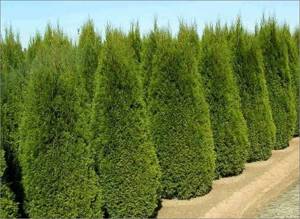
Thuja Smaragd (“Smaragd”).
Columna is another popular tree among gardeners. The crown shape is columnar. The height reaches 7 meters.
Woodwardie is a spherical thuja. The height of the bush is small, no more than 2 meters. It is used in mixborders and various multi-contrast landscape compositions.
Planting thuja occidentalis
Thuja occidentalis is absolutely unpretentious and can grow in both sun and partial shade. The plant is also undemanding to the composition of the soil; it tolerates even close proximity to groundwater, but on dry soils the needles of the western thuja fade, the crown becomes sparse, and the plant produces too many cones.
- Names and photos of home tradescantia
Planting and caring for western thuja will not seem difficult to you. When placing seedlings on the site, keep an interval of at least 3 m between them, primarily this applies to tall forms. In a hedge with a two-row planting, the distance between thujas should be 50-70 cm, and with a single row - 40-50.
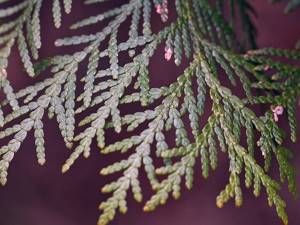
Thuja is planted in the spring. The pits for this plant do not need to be prepared in advance. The depth of the pit should be from 60 to 100 cm. A drainage layer of broken brick 20 cm thick is laid on its bottom, and then the hole is filled to half the depth with a pre-prepared soil mixture consisting of humus (3 parts), leaf soil (2 parts), peat (1 part) and sand (2 parts) with the addition of 100-120 g of Nitroammofoska.
Before planting, the root system of the seedling must be kept in a container of water so that the roots are saturated with moisture. Then the seedling is placed in the center of the hole and the remaining space is filled with the same nutritious soil. The surface around the plant is trampled and watered abundantly. The root collar of the seedling should be flush with the surface. As soon as the water is absorbed, the tree trunk circle is mulched with peat, humus or other organic material.

Thuja occidentalis Yellow Ribbon
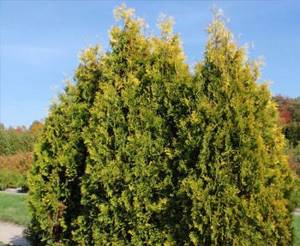
T. occidentalis 'Yellow Ribbon' is a low tree with a narrowly conical (somewhat spindle-shaped)
form. It grows quite slowly - by the age of 10 it reaches 1.4-1.6 m in height and 0.5-0.6 m in diameter. At maturity, the height of the tree does not exceed 2.2 m, the diameter is 0.9 m. The crown is slightly sparse, starting 10-15 cm from the ground surface.
The needles are flattened and yellowish-green in color. On annual shoots (especially at their tips)
the needles are bright yellow with an orange tint. This coloring is the basis of the decorative effect of Yellow Ribon.
Requires open sunny habitats. In partial shade it almost completely loses its decorative effect. It may die in the shadows.
It tolerates air drought with difficulty. Requires periodic sprinkling throughout the summer.
It also has a negative attitude towards soil moisture. Does not tolerate waterlogged areas. However, it prefers a slightly moistened substrate. It needs light, fertile, slightly acidic soils. It develops better on peaty sandy loam or an artificial substrate prepared from equal parts of peat, leaf soil, and mature humus. Up to 10% river sand must be added to this mixture. Frost-resistant down to -35°C.
Can be used as a tapeworm, as well as in compositions with other types of coniferous trees and shrubs to add a color accent. If desired, it can be used for arranging single-row hedges.
Thuja care
Growing conditions
The first month after planting, thuja is watered weekly, using 10 liters of water at a time. The young plant also needs weekly irrigation of the crown from a watering can with a shower head, which is carried out after sunset. Water consumption for a shower procedure is 15-20 liters. During the dry period, the amount of water during irrigation increases to 15-20 liters per plant, and sprinkling is carried out twice a week. After watering, the soil around the thuja is loosened to a depth of 10 cm.
Young plants are fed the first two years in the spring with complex mineral fertilizer.
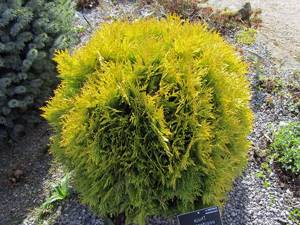
Older plants require almost no care.
Western thuja needs to be protected from spring burns. To do this, in late autumn, its trunk is covered with lutrasil or burlap, and so that heavy snowfall does not damage the branches of the tree, they are tied with synthetic rope or twine. Young trees are completely covered for the winter with spunbond or lutrasil.
Transfer
Due to the fact that the root system of the thuja is superficial, it tolerates transplantation quite easily. In areas where the groundwater is shallow, it is better to replant western thuja in September; in other cases, this can be done in the spring. The transplant is carried out in the same sequence as the primary planting: prepare a hole taking into account the size of the root system of the transplanted plant, put drainage in it, and prepare the soil mixture. After this, the thuja is dug up around the perimeter, retreating 40-50 cm from the trunk, dragged on dense polyethylene to a new place, the root system is treated with a root former solution (Kornevin) and planted.
The first time after transplantation, thuja occidentalis needs frequent watering and mandatory protection from the sun.
Diseases and pests
Most often, the shoots and branches of the western thuja turn brown or dry out. These diseases are caused by fungal infections.
Brown shoots: in early spring, individual scales or needles on the plant turn yellow, and later the entire shoot turns brown and dies. Such shoots should be removed immediately, and the thuja should be treated with a two percent solution of Fundazol every two weeks from July to October.
Drying of shoots: this phenomenon can have two reasons: root soaking and fusarium, or tracheomycosis, caused by soil fungi. First, the leaves on the plant turn yellow and fall off, the young growth turns brown, followed by the tops of adult shoots, and this indicates that nutrients have stopped flowing from the roots to the crown. If the nature of the phenomenon is fungal, thuja occidentalis and the soil around it should be treated with two percent Fundazol or a preparation with a similar effect: Kartotsid, Abiga-Peak, HOM. At the same time, the plant’s resistance to fungal infections should be increased by treating with Zircon. As a preventive measure, regular treatments of thuja from spring to autumn with Zineb or copper-containing preparations are used.
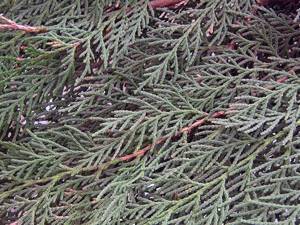
Among the pests that are dangerous for the western thuja are the thuja aphid, thuja false scale insects and the moth.
- The best varieties of white rose
The moth is only about 4 mm in size, but its harmful activity causes the thuja scales to turn brown and the tops of the shoots to die. Moth larvae gnaw tiny tunnels in the needles, causing the plant to wither away. In order to prevent the spread of butterflies, it is necessary to treat the plant twice at the end of June with an interval of a week with pyrethroids - Cypermethrin or its isomers.
The thuja aphid feeds on the sap of the needles, causing the scales to turn yellow and fall off, and the decorativeness of the plant is sharply reduced. Aphids are destroyed by treating thuja with Karbofos, and, most likely, one spraying will not be enough.
The false scale insect also causes great harm to the thuja, appearing on the plant in May-June. One clutch of this insect can contain more than a thousand eggs. The larvae begin to destroy thuja needles already in July: in their habitat, the needles take on a chlorotic appearance. To protect thuja occidentalis from false scale insects, it is treated with Actellik, Rogor, Antio or Karbofos before bud break and in the summer, at the end of June or beginning of July.
Thuja occidentalis Tiny Team
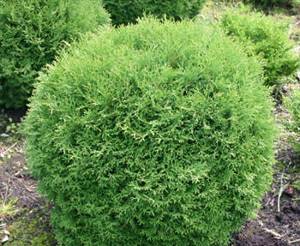
T. occidentalis 'Tiny Tim' is a dwarf shrub. The height of an adult plant barely reaches 1 m with a crown width of 1.5 m. It grows extremely slowly, the increase in both height and diameter does not exceed 4 cm per year. Habitus – flattened-spherical. The crown is compacted. It is formed by short and dense branches growing almost vertically. A characteristic feature of these branches is a slight crescent-shaped curve.
The needles are scaly, flattened, green - dark green in color. In winter, the color of the needles becomes brown.
Loves both well-lit areas and partial shade. In partial shade, the crown thickens and becomes somewhat denser. It can grow in the shade, but it develops worse, losing density and, as a consequence, the decorativeness of the crown.
It tolerates atmospheric dryness easily. It will not refuse sprinkling, but will survive the spring-summer period just fine without it.
Also, the Tiny Tim form easily relates to soil moisture. Capable of growing and developing normally, while maintaining an excellent decorative appearance in both waterlogged and dry soils. This form is also absolutely not demanding on soil fertility. Soil acidity limits range from pH 4.5 to pH 7.
Winter-hardy. Easily tolerates frosts down to -30°C and short-term frosts down to -35°C.
Well suited for alpine slides, rockeries, Japanese gardens. Can be used as an auxiliary element when laying curtains and in small mixborders.
Trimming
Thuja occidentalis is not at all afraid of pruning, but there are a few simple rules to know that will help you keep the plant in its best shape. The crown of each of the decorative varieties of thuja takes on a certain geometric shape in the process of growth: there is a spherical thuja, there is a pyramidal, ovoid and columnar. Based on this, there is no particular need to shape the tree, unless you decide to give the thuja a shape that is unusual for the variety. However, sanitary cleaning of the crown must be done in any case. What are the rules for pruning thuja occidentalis?

You can trim the plant in early spring, summer and autumn in cloudy weather, since the sun's rays dry out the needles damaged during cutting.
Any pruning, including formative pruning, must begin with the removal of diseased and dried branches, after which the plant must be treated with a fungicide.
There is no need to treat cuts on thuja occidentalis branches with garden varnish.
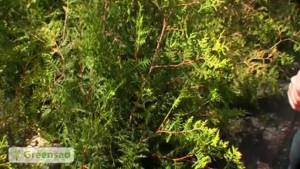
Reproduction of thuja occidentalis
Thuja occidentalis reproduces by seeds and vegetatively. Seed propagation is possible only for species plants, and forms and varieties with this method do not retain the properties of the parent plants. In addition, this is a complex and lengthy process, expected to take 3-5 years, but if there are enthusiastic breeders among the readers, we are ready to share the technology for generative cultivation of thuja occidentalis.
Seed propagation
Thuja seeds extracted from freshly collected and dried cones are sown in the ground before winter so that they undergo natural stratification in the cold soil. To do this, fill a wooden box with a damp mixture of garden or turf soil (1 part), peat (2 parts) and sand (half part), level the surface, make grooves in it at intervals of 5-6 cm, into which the seeds are sown. Planting depth is 1 cm. After sowing, the surface is compacted and sprayed with a spray bottle. The box is placed in the shade of trees and protected from animals with lutrasil, but care must be taken that the shelter does not touch the soil in the box.
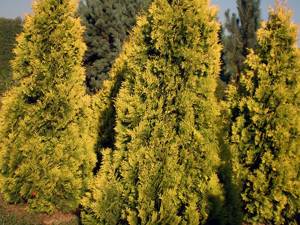
The first shoots of thuja occidentalis will appear in the spring, 2-3 weeks after the ground warms up to 10-15 ºC. Please note that the needles of seedlings are needle-shaped and not scaly, like those of adult plants. Twice a month, feed the seedlings with a solution of complete mineral fertilizer, and when the box becomes too small for them, plant the seedlings in a school bed located in partial shade. You must first add a bucket of humus, 250 g of wood ash and 40 g of Nitroammofoska per 1 m² to the soil in the garden bed. Transplantation of seedlings is carried out according to the 30x30 cm pattern. The root collar should be at surface level. After planting, water the bed and mulch the surface with organic material. Continue to water and feed the seedlings with the same regularity, loosen the soil around them, and in the third year, when the young thujas reach a height of 50 cm, they can be planted in a permanent place.
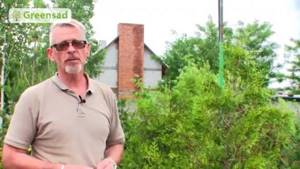
Propagation by lignified cuttings
Forms and varieties of thuja occidentalis are propagated by cuttings. As cuttings, use lignified sections of two to three year old shoots 25-40 cm long or semi-lignified sections of the current year's growths 10-20 cm long, which are cut in June. Cuttings are prepared with a heel, that is, with a piece of a branch from which a shoot has grown. The lower part of the cuttings is freed from twigs and needles, and the lower sections are treated with a Heteroauxin solution, after which the cuttings are planted at an angle of 60º in a greenhouse in a mixture of river sand, peat and turf soil in equal proportions so that the needles remaining on the cuttings do not come into contact with the substrate . Planting depth is from 1.5 to 2.5 cm. After planting, sprinkle the surface of the substrate with sand and press it lightly. It is very important to maintain a temperature of 23 ºC and high air humidity (within 70%) in the greenhouse, and for this, watering the cuttings is replaced by regular spraying. When the cuttings take root, caring for them will consist of ventilation, watering and fertilizing, and when you are sure that they are sufficiently hardened, you can plant them in a permanent place. In November, the cuttings are insulated with sawdust, leaves or spruce branches, and with the onset of frost -5-7 ºС they are additionally covered with film.
Thuja occidentalis Golden Globe
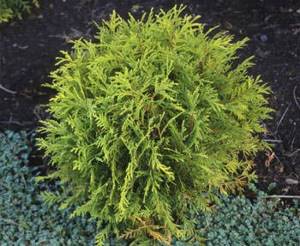
T. occidentalis 'Golden Glob' is a low shrub, reaching no more than a meter in height. Grows slowly - 3-6 cm per year. By the age of ten it barely reaches 0.5 m. The habit is either regularly spherical or, sometimes, ovoid-spherical. The crown, starting about 5 cm from the ground, is dense and compacted. Its diameter in an adult plant reaches a meter. The needles at the ends of the shoots are yellow with a golden tint, and yellow-orange in autumn. Inside the crown, the needles are scaly and bright green.
It is demanding on lighting. Prefers open sunny places, or, in extreme cases, light partial shade. In shade, even intermittent shade, the needles at the ends of the shoots lose their golden-yellow hue and become simply light green.
Air dryness is extremely difficult to tolerate. Requires periodic sprinkling.
It is undemanding to soils. Prefers freshly moistened humus-rich loams. Does not like stagnant water in soils. In over-watered areas it requires drainage and aeration. Does not like highly alkaline soil conditions.
Exceptionally frost-resistant. Some specimens tolerate temperatures below -35°C.
Can be used in single plantings, to decorate curtains, rock gardens or rockeries.
Western thuja varieties
Numerous decorative forms of thuja occidentalis are divided into five groups:
- group A: thujas of normal height for the species with green needles, which sometimes turn brown in winter. This group includes columnar-shaped thujas (Columna, Filiformis, Pendula, Fastigiata, also Stricta, and Malognana), loose-knotted thujas (Bodmera, Douglas, Spiralis and Pyramidalis) and thujas of special shapes, for example, narrow- or wide-pointed (Gracilis , Indomitble, Smaragd, Goetz Wintergreen);
- group B: dwarf thujas with green scale-like needles. This group in particular includes thujas with an ovoid and round crown (Danika, Globoza, Goetz, Little Champion, Recurva nana, Little Gem, Midget, Dumoza), thujas whose crown becomes pin-shaped only with age (Tiny Tim, Thuja Woodward, Umbraculifera ) and thujas with an initially pin-shaped crown (Holmstrup, Thuja Rosenthal);
- group B: thujas with variegated scale-like needles. For example, thujas with yellow needles (Close of Gold, Golden Globe, Lutea, Lutea nana, Sunkist, Vareana lutescens, Semperaurea, Yuerep Gold) and thujas with variegated white needles (Meinekes Zwerg);
- group G: forms with both scaly and needle-like needles (Ellvan geriana, Ellvan Aurea, Reingold);
- group D: thuja with needle needles (Ericoides, thuja Ohlendorf).
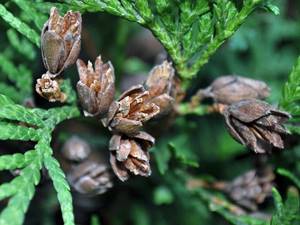
We offer you the varieties of western thuja that are most often grown in cultivation:
- Thuja occidentalis Smaragd is a squat plant of Danish selection up to 2 m high with a cone-shaped shape and weak branching. The shoots of the plant are located vertically, and the glossy, green branches in both winter and summer are far apart from each other. The plant is highly decorative;
- Thuja occidentalis Brabant is a tree with a height of 15 to 21 m with a conical crown with a diameter of 3-4 m. The bark of the plant is grayish-brown or reddish, exfoliating from the trunk. The cones are oblong-ovate, brown. The needles are scaly, green, retaining color even in winter;
- Thuja occidentalis Bowling Ball is a dwarf plant with an almost spherical crown. The needles of this form are soft, scaly, thread-like, dark green in summer, with a slight bronze tint in winter;
- Thuja occidentalis Danica is also a dwarf variety, bred in 1948 in Denmark. The plant reaches a height of 60 cm, and the diameter of the spherical crown is 1 m. Danika’s bark is peeling, gray-brown or reddish, the needles are scaly, soft, thick, shiny, green, and in winter with a brownish tint;
- Thuja occidentalis Aurea is a small or medium-sized plant with golden-green needles, sometimes bush-like. The crown of this variety is in the shape of a wide cone;
- Thuja western Woodward is a plant with a height of 1.5 to 2.5 m with a spherical crown with a diameter of up to 5 m, which becomes broadly rounded in old age, and dark green needles at any time of the year. The variety has been in cultivation since 1923;
- thuja western Globoza (or Globoza) - plant height 120 cm, rounded crown reaches 1 m in diameter. Densely located shoots are raised upward, scale-like needles with shiny glands are green or gray-green in summer, and brownish in winter;
- Thuja occidentalis Golden Globe is a mutation of Woodward's thuja with a rounded crown and yellow needles;
- Thuja occidentalis Miriam is a variety of the Danika variety, a slow-growing dwarf shrub with a spherical dense crown with a diameter of about 80 cm. The needles are scale-like, yellow-green, bronze in winter, and again acquiring a yellowish tint in spring;
- Thuja occidentalis Columna is a slow-growing tree, reaching a height of 10 m. Its crown is columnar, the bark is rough, red-brown, the needles are dense, scale-like, shiny, dark green all year round;
- Thuja occidentalis Tiny Tim is a very beautiful but slow-growing dwarf plant, bred in 1955. It reaches a height of 50 to 100 cm, and the diameter of the spherical crown is from 1 to 1.5 m. The bark of the plant is peeling, grayish-brown or reddish, the needles are scaly, dark green;
- Thuja occidentalis Holmstrup is a variety obtained by Danish breeders in 1951. It is a shrub 3-4 m high with a conical crown up to 1 m in diameter, reddish or grayish-brown exfoliating bark and dense scaly green needles;
- Thuja occidentalis Teddy is a new variety that has quickly become popular. This is a slow-growing dwarf shrub with a cushion-shaped crown and non-thorny needle-like needles of a dark green color, which turn brown in winter;
- Thuja western Yellow Ribbon is a low tree with a conical crown. The needles on the current year's shoots are bright yellow, almost orange, but gradually they become light green, and by winter they acquire a bronze tint.
Description of western thuja
Thuja occidentalis (Latin name) is a member of the Cypress family and is represented by low spherical shrubs and trees with almost horizontal long branches. If you look closely, you will notice that the plant’s needles are scaly, but those of the garden forms are needle-shaped. In both cases they are located close to each other.
The crown comes in only two types: like that of ordinary trees, that is, pyramidal and rounded - typical for bushes
In characterizing the western thuja, it is also worth mentioning its homeland - the northern part of the American continent. Here, in its natural habitat, it can grow up to 12 meters. In Europe, thuja is often found in the design of park areas, and in Russia in steppe and forest areas.
In our area, the tree does not grow up to 12 meters, so do not be alarmed by the previously indicated sizes. By the way, it is easy to trim, which means that the crown can be shortened to the desired height at any time.
The compact crown makes the tree similar to cypress. Young western thuja has smooth red-brown bark. With age, longitudinal ribbons appear on it, which separate over time, and the color changes to gray-brown.
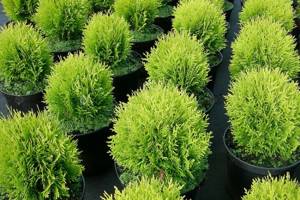
The shoots are very short. But there are also long ones. Externally, the branches are very reminiscent of the leaf blades of an indoor fern. In winter the needles are brown-green, in other seasons they are shiny.
The needles are very small and pressed quite tightly. Life cycle – 3 years. They fall with the branches. The cones are very small - maximum size 1 cm. They ripen simultaneously with the onset of the flowering period.
Western thuja varieties
There are many varieties. They differ in the height and silhouette of the crown, and the properties of the needles. Among dwarf species it is worth highlighting the following species:
- Compacta - reaches two meters. Crown Compacts are ovoid or conical in shape. The needles are green with a blue tint;
- Danica - the variety almost never exceeds 50 cm. Danica has an ovoid crown with green needles, which turn brown in cold weather;
- Dumosa - the diameter of the thuja western Dumosa reaches only one meter. The crown is slightly flattened and rounded. There are many shoots at the top. The needles remain green all year round and do not change color.
- Ericoides – develops up to 1 m. The needles are needle-shaped and very soft. They are yellow-green above, with a grayish tint at the bottom;
- Umbraculifera – behind the beautiful name Umbraculifera hides an original appearance with an umbrella-shaped crown. Slow-growing thuja is sensitive to competitors, that is, planting too close to large trees is not recommended. The variety fits perfectly into the compositions of heather and small gardens;
- Filiformis - the bush rises to 1.5 m. The crown is distinguished by the thinness of the branches hanging to the ground;
- Globosa – the height of the western Globosa thuja does not exceed 2 meters. The crown grows evenly. In summer the needles are green, but with the onset of cold weather they turn brown or gray. Growth is slow. Requires frequent and abundant watering. Every 2 years, pruning is necessary for rejuvenation purposes. In youth it has a rounded crown shape, which changes to cone-shaped with age.
- Hoveyi - needles do not change color. Regardless of the season, they retain their light green color;
- Little Gem – round crown, green needles, grows up to 1 m;
- Lutea Nana – rises to 2 m. The needles are yellowish in color;
- Ohlendorfii - the shrub rarely grows higher than 1 m. Red needles with a brown tint;
- Recurva Nana – translated means “low curved”. The tips of young shoots are usually twisted. Due to its density, the crown resembles moss;
- Smaragd - western thuja Smaragd is one of the most famous varieties. The height rarely exceeds 3 m. Cone-shaped crown. Smaragd is very similar to cypress. The needles retain their emerald green color all year round. Even in winter they do not fade. Needs moist soil for full development;
- Teddy is a new variety that has captivated us with its unique crown shape. An evergreen species with soft needles, it is unpretentious in care and grows well in different soils. Teddy is frost-resistant, but sensitive to burns. Therefore, in the spring it needs additional protection.
- Brabant - thuja occidentalis Brabant grows up to 5 meters. The crown grows 1.5 m in diameter. Growth is very fast. Over the course of a year, it increases up to 35 cm. The color of the needles is green, but in winter it turns slightly brown. The Brabant variety is undemanding in terms of care;
- Europe Gold - Europe Gold is a shrub whose height sometimes exceeds 4 m. But growth is slow. In youth, the narrow crown is pyramidal in shape, and with age it acquires the shape of a cone. The needles are orange. In winter it takes on a golden yellow hue. Grows well in the shade;
- Wagnerii - Wangneri is distinguished by an elegant crown, the conical shape of which is directed upward. It grows up to 3.5 meters in height. The needles are gray-green, with the onset of cold weather a copper tint appears. This variety has an average growth rate. Loves brightly lit sunny areas;
- Stolwijk – Stolwijk is a spherical shrub. Despite the green needles, young growth can be distinguished by its yellowish-white color. Does not tolerate dry air;
- Little Dorrit – as the name suggests, Little Dorrit is a dwarf plant. Prefers acidified soil; when young, the needles suffer from spring burns;
- Golden Globe – Golden Globe is growing slowly. Over the course of a year, the shrub adds only 8-10 cm. The golden-yellow needles turn copper in the fall. Prefers partial shade for growth. To increase the density of the crown, gardeners recommend regular pruning.
- Golden Tuffet – the dwarf Golden Tuffet surprises with its cushion-shaped crown. The variety is slow growing. Over 10 years of active development, the bush rises only 40 cm. It is photophilous, but also feels great in partial shade. But in shaded areas, the golden needles darken, and the crown thins out significantly. It does not develop well in dry soil, as it prefers humus-rich substrates.
It is recommended to plant in sunny areas, protected from strong winds that dry out the soil and air.
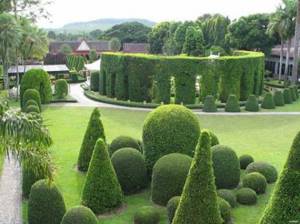
Types of thuja occidentalis
- Douglas variety
It is often confused with cypress due to the columnar shape of the crown. Height is limited to 10-15 meters. The shoots are thin and short. The green branches are similar in shape to the leaf blades of a fern.
The needles are swamp green. The needles located on the lower branches dry quickly and subsequently fall off. This species, like the main one, is very winter-hardy and can develop well in the shade.
Propagated twice a year by cuttings.
- Filiformis
Develops up to 1.5 meters. The tree has a very dense, round or conical crown. Compared to the previous species, the shoots of Filiformis are drooping. When young, the needles are light green in color.
The structure is scaly. With cold weather it gradually turns brown. Reproduction can be done either by seeds or cuttings. Filiformis varieties are used in arranging rocky gardens.
Thuja occidentalis in landscape design
Coniferous plants are of particular value for landscape design. They are widely used for landscaping squares, parks, gardens and, of course, personal plots. Moreover, they are good both in single plantings and in group compositions. The undeniable advantage of coniferous plants is their ability to maintain greenery even in the winter season.
- Smoking tobacco: cultivation, collection and storage
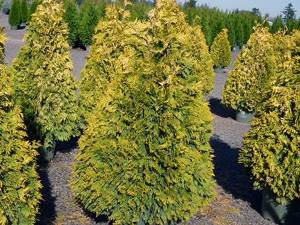
Among the many coniferous plants, thuja occidentalis is the most popular among designers and gardeners, primarily due to the large number of garden forms, varieties and varieties that belong to it. Tall, slender thujas are used for hedges (Brabant, Smaragd, Holmstrup), forms with a spherical crown are often planted on lawns as solo plants (Danika, Tiny Tim, Teddy), and dwarf varieties are grown in rock gardens and rockeries.
Western thuja is equally organic in rocky gardens, a traditional front garden, as a border and hedge, especially since this plant is an excellent material for shaping and cutting. It is used to create not only rectangular and trapezoidal shapes, but also more complex figures - people, animals, castles with loopholes and other works of garden art.
Content
- Thuja occidentalis Smaragd
- Thuja occidentalis Elvanger
- Thuja occidentalis Elvangera Aurea
- Thuja occidentalis Globoza
- Thuja occidentalis Rheingold
- Thuja occidentalis Danica
- Thuja occidentalis Golden Globe
- Thuja western Heather
- Thuja occidentalis Brabant
- Thuja occidentalis Columna
- Thuja occidentalis Holmstrup
- Thuja occidentalis Woodwardy
- Thuja occidentalis Yellow Ribbon
- Thuja occidentalis Sunkist
- Thuja occidentalis Spiralis
- Thuja occidentalis Tiny Team
- Thuja occidentalis Recurva Nana
- Thuja occidentalis Teddy
- Thuja occidentalis Filiformis, filamentous

